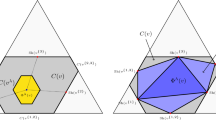Abstract
This article reports a comparative test of the central-union theory vis-à-vis several other game-theoretic solution concepts in 3-person sidepayment games. Based on a laboratory experiment, this comparison utilizes nine games in characteristic function form. The solution concepts under test include the equal excess model, the Myerson–Shapley solution, the kernel, and two variants of the central-union theory (CU-1 and CU-2). With regard to the player's payoffs, results show that the CU-1, CU-2, kernel, and equal excess theories have essentially equal predictive accuracy and that all of these are more accurate than Myerson–Shapley. When the solution concepts are extended and coalition structure probability predictions are incorporated in the test, one version of the central-union theory (CU-2) is overall more accurate than the other solutions.
Similar content being viewed by others
REFERENCES
Aumann, R.J. and Dreze, J.H. (1973), ‘Cooperative games with coalition structures', International Journal of Game Theory 3: 217–237.
Aumann, R.J. and Maschler, M. (1964), ‘The bargaining set for cooperative games', in M. Dresher, L.S. Shapley and A.W. Tucker (eds.), Advances in Game Theory (Annals of Mathematics Studies No. 52), Princeton University Press, Princeton, NJ.
Aumann, R.J. and Myerson, R.B. (1988), ‘Endogenous formation of links between players and of coalitions: An application of the Shapley value', in A.E. Roth (ed.), The Shapley Value: Essays in Honor of Lloyd S. Shapley, Cambridge University Press, Cambridge.
Bonacich, P. (1979), ‘A single measure for point and interval predictions of coalition theories', Behavioral Science 24: 85–93.
Charnes, A. and Littlechild, S.C. (1975), ‘On the formation of unions in n-person games', Journal of Economic Theory 10: 386–402.
Charnes, A., Rousseau, J. and Seiford, L. (1978), ‘Complements, mollifiers, and the propensity to disrupt', International Journal of Game Theory 7: 37–50.
Davis, M. and Maschler, M. (1965), ‘The kernel of a cooperative game', Naval Research Logistics Quarterly 12: 223–259.
Gillies, D.B. (1953), ‘Some theorems on n-person games', Doctoral dissertation, Department of Mathematics, Princeton University.
Gillies, D.B. (1959), ‘Solutions to general non-zero-sum games', Annals of Mathematics Studies 40: 47–85.
Horowitz, A.D. (1973), ‘The Competitive bargaining set for cooperative n-person games', Journal of Mathematical Psychology 10: 265–289.
Johansen, L. (1982), ‘Cores, aggressiveness and the breakdown of cooperation in economic games', Journal of Economic Behavior and Organization 3: 1–37.
Kirk, R.E. (1982), Experimental Design, 2nd edition, Brooks/Cole, Belmont, CA.
Komorita, S.S. (1978), ‘Evaluating coalition theories: Some indices', Journal of Conflict Resolution 22: 691–706.
Komorita, S.S. (1979), ‘An equal excess model of coalition formation', Behavioral Science 24: 369–381.
Komorita, S.S., Hamilton, T.P. and Kravitz, D.A. (1984), ‘Effects of alternatives in coalition bargaining', Journal of Experimental Social Psychology 20: 116–136.
Komorita, S.S. and Kravitz, D.A. (1981), ‘Effects of prior experience on coalition bargaining', Journal of Personality and Social Psychology 40: 675–686.
Littlechild, S.C. and Vaidya, K.G. (1976), ‘The propensity to disrupt and the disruption nucleolus of a characteristic function game', International Journal of Game Theory 5: 151–161.
Maschler, M. (1963), ‘The power of a coalition', Management Science 10: 8–29.
Maschler, M., Peleg, B., and Shapley, L.S. (1979), ‘Geometric properties of the kernel, nucleolus, and related solution concepts', Mathematics of Operations Research 4: 303–338.
Michener, H.A. (1992), ‘Coalition anomalies in light of the central union theory', in E.J. Lawler, B. Markovsky, C. Ridgeway, and H.A. Walker (eds.), Advances in Group Processes, Vol. 9, JAI Press, Greenwich, CT.
Michener, H.A. and Au, W.T. (1994), ‘A probabilistic theory of coalition formation in n-person sidepayment games', Journal of Mathematical Sociology 19: 165–188.
Michener, H.A, Macheel, G.B., Depies, C.G. and Bowen, C.A. (1986), ‘Mollifier representation in non-constant-sum games: an experimental test', Journal of Conflict Resolution 30: 361–382.
Michener, H.A. and Myers, D.J. (1997), ‘Probabilistic coalition structure theories: An empirical comparison in 4–person superadditive sidepayment games.’ Technical Report, Department of Sociology, University of Wisconsin-Madison.
Myerson, R.B. (1977), ‘Graphs and cooperation in games', Mathematics of Operations Research 2: 225–229.
Postlewaite, A. and Rosenthal, R.W. (1974), ‘Disadvantageous syndicates', Journal of Economic Theory 9: 324–326.
Rapoport, Am. (1987), ‘Comparison of theories for payoff disbursement of coalition values', Theory and Decision 22: 13–47.
Rapoport, Am. and Kahan, J.P. (1976), ‘When three is not always two against one: Coalitions in experimental three-person cooperative games', Journal of Experimental Social Psychology 12: 253–273.
Rapoport, Am. and Kahan, J.P. (1979), ‘Standards of fairness in 4–person monopolistic cooperative games', in S.J. Brams, A. Schotter, and G. Schwodiauer (eds.), Applied Game Theory, Physica-Verlag, Wurzburg.
Rapoport, Am. and Kahan, J.P. (1982), ‘The power of a coalition and payoff disbursement in three-person negotiable conflicts', Journal of Mathematical Sociology 8: 193–224.
Schmeidler, D. (1969), ‘The nucleolus of a characteristic function game', SIAM Journal of Applied Mathematics 17: 1163–1170.
Shapley, L.S. (1953), ‘A value for n-person games', in A.W. Kuhn and A.W. Tucker (eds.), Contributions to the Theory of Games II (Annuals of Mathematics Studies, No. 28), Princeton University Press, Princeton, NJ.
Author information
Authors and Affiliations
Rights and permissions
About this article
Cite this article
Michener, H.A., Myers, D.J. An Empirical Comparison of Probabilistic Coalition Structure Theories in 3-Person Sidepayment Games. Theory and Decision 45, 37–82 (1998). https://doi.org/10.1023/A:1005035407253
Issue Date:
DOI: https://doi.org/10.1023/A:1005035407253




